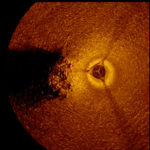Date: Late 4th-early 5th century BCE
Era: Late Roman
Location: Montenegro Coast
Cargo: predominately African 3 amphoras
A scattered and badly damaged wreck (MN10-AF) was discovered within a couple of km off shore and formed a low, wide mound. Many broken amphoras and fragments were located on the surface, and amphoras were also noted protruding up through the sandy mound. Hence, there may be additional amphoras buried beneath, that are in better condition than those on the surface. It is clear that drag nets are responsible for the damage to the site.
Although difficult to ascertain completely due the fragmentary nature of many of the ceramics, at least a large percentage of the visible cargo is comprised of African 3 amhoras; a rim-neck-handle fragment was raised for analysis (artifact number MN10AF-0001). The raised is a sub-type C of the African 3 type, and dates to the second half of the 4th – first half of the 5th century CE and was produced in Tunisia. This type is frequently found in the W Mediterranean and particularly on land and shipwreck sites of S France. Fish or fish products were the most likely contents for this amphora type; however, olives were carried in this type on the early 5th-century Dramont E wreck in S France and wine cannot be excluded as a product.
Although relatively infrequent in the Adriatic finds of Croatia, a wrecksite carrying African 3 amphoras, all three sub-types, was found in 2009 off the coast of Albania (a sub-type C). The Joni Wreck is relatively intact and carried a secondary cargo of E Mediterranean amphoras. These two wrecks carrying Tunisian amphoras speak to the eastern Adriatic route for maritime trade and trade patterns of Late Antiquity.

